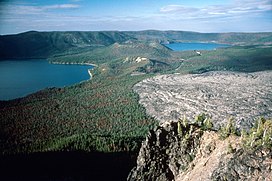| Newberry Volcano | |
|---|---|
 Newberry Caldera, with Paulina Lake, East Lake, and Big Obsidian Flow. | |
| Highest point | |
| Elevation | 7,989 ft (2,435 m)[1] |
| Coordinates | 43°41′21″N 121°15′18″W / 43.689195264°N 121.25488985°W[1] |
| Geography | |
| Location | Deschutes County, Oregon, U.S. |
| Parent range | Cascade Range |
| Topo map | USGS Paulina Peak |
| Geology | |
| Age of rock | About 600,000 years old |
| Mountain type | Characteristics of both shield volcanoes and composite volcanoes |
| Volcanic arc | Cascade Volcanic Arc |
| Last eruption | 690 AD[2] |
| Climbing | |
| Easiest route | Road to Paulina Peak |
| Designated | 1976 |
Newberry Volcano is a large, active, shield-shaped stratovolcano located about 20 miles (32 km) south of Bend, Oregon, United States, 35 miles (56 km) east of the major crest of the Cascade Range, within the Newberry National Volcanic Monument. Its highest point is Paulina Peak. Newberry is the largest volcano in the Cascade Volcanic Arc, with an area of 1,200 square miles (3,100 km2) when its lava flows are taken into account. From north to south, the volcano has a length of 75 miles (121 km), with a width of 27 miles (43 km) and a total volume of approximately 120 cubic miles (500 km3). It was named for the geologist and surgeon John Strong Newberry, who explored central Oregon for the Pacific Railroad Surveys in 1855.
The volcano contains a large caldera, 4 by 5 miles (6.4 km × 8.0 km) in diameter, known as the Newberry Caldera. Within the caldera are two lakes: Paulina Lake and East Lake. The volcano and its vicinity include many pyroclastic cones, lava flows and lava domes; Newberry has more than 400 vents, the most of any volcano in the contiguous United States. Glaciers may have once been present at the volcano, though this remains contested. The area has a dry climate with low precipitation levels and little surface runoff.
The origin of the volcano remains somewhat unclear; while some scientists believe it originated from an independent hotspot, most evidence indicates that it formed from the subduction of the oceanic Juan de Fuca and Gorda tectonic plates under the continental North American Plate. Eruptive activity at Newberry Volcano began about 600,000 years ago and has continued into the Holocene, the last eruption taking place 1,300 years ago. Unlike other shield-shaped volcanoes, which often erupt basaltic lavas only, Newberry Volcano has also erupted andesitic and rhyolitic lavas. A popular destination for hiking, fishing, boating, and other recreational activities, the volcano lies within 19 miles (31 km) of 16,400 people and within 62 miles (100 km) of nearly 200,000 people, and it continues to pose a threat to life. Still considered an active volcano, it could erupt and produce lava flows, pyroclastic flows, lahars (volcanically induced mudslides, landslides, and debris flows), ashfall, earthquakes, avalanches, and floods. To track this threat, the volcano and its surroundings are closely monitored with sensors by the United States Geological Survey.
- ^ a b "Paulina Peak BM". NGS Data Sheet. National Geodetic Survey, National Oceanic and Atmospheric Administration, United States Department of Commerce. Retrieved January 13, 2018.
- ^ "Newberry". Global Volcanism Program. Smithsonian Institution. Retrieved 2020-09-21.


